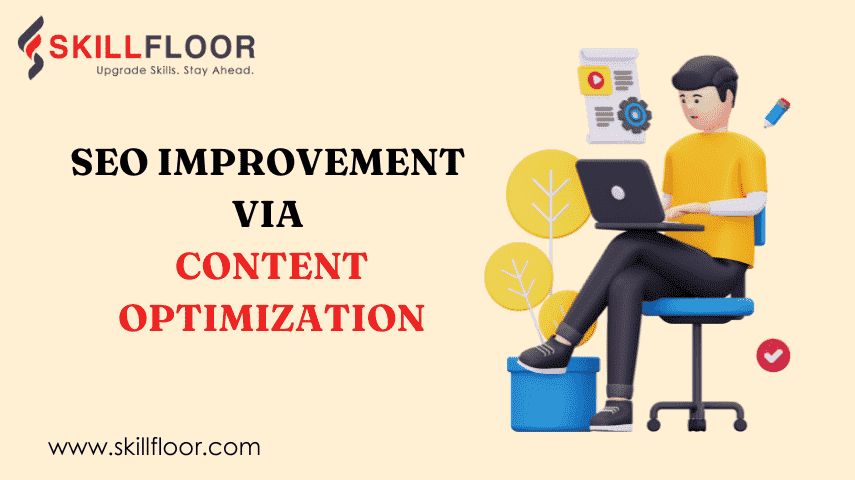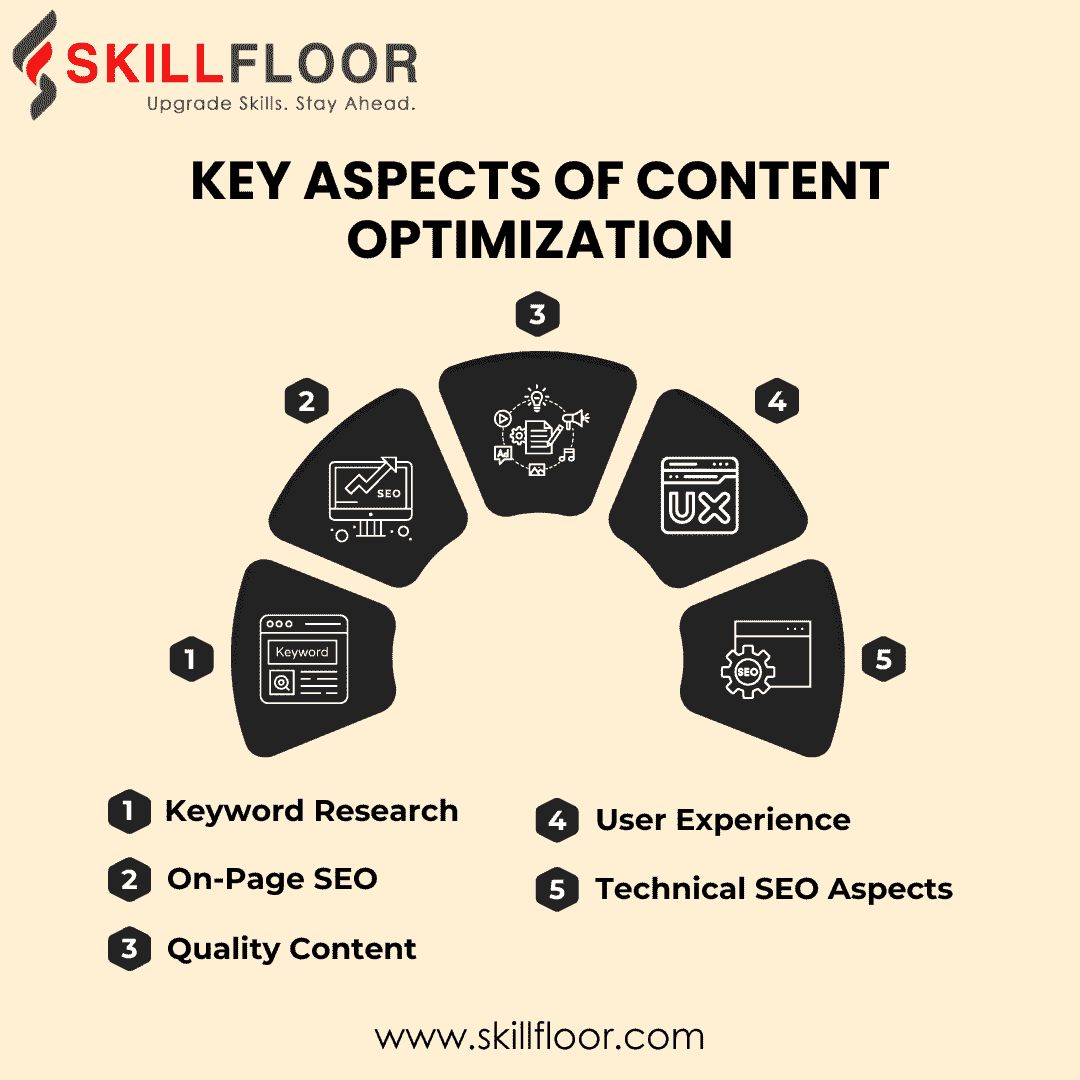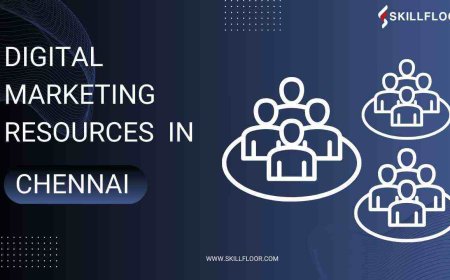what is content optimization in SEO?
Learn about content optimization in SEO, including strategies to improve website visibility, drive traffic, and enhance user engagement.

Do you want to improve your internet visibility? Simply creating content isn’t enough. Your content must be optimized for search engine optimization to stand out and draw in more people. Increasing the visibility of your website requires a solid understanding of content optimization in SEO. It is a crucial component of successful digital marketing that may significantly impact your audience outreach.
Search Engine Optimization, or SEO, is all about making your website visible. SEO makes sure your website shows up higher in the search results when people look for something on Google. This implies a higher chance of people seeing and clicking on your link. In summary, SEO raises the visibility of your website and increases the likelihood that you will draw in more people.
Let's say you have a fantastic blog article, but it appears on page 10 of Google searches. No matter how excellent your content is, it won't be effective if no one can discover it. Here's when content optimization in SEO becomes useful.
What is SEO Optimization?
SEO optimization is all about making your website more visible on search engines like Google. It entails making several site improvements to raise its search engine ranking. To make it easier for individuals to locate your website when they search for subjects linked to your content is the aim.
Why SEO Optimization is Important?
-
Increased Visibility: It's simpler for people to find you when your website ranks higher in search results thanks to efficient SEO optimization. More potential visits to your website equates to more visibility.
-
Higher Traffic: Increased organic traffic is a result of good SEO optimization. A higher position gets you more clicks from people who are drawn to your material, which increases traffic to your website as a whole.
-
Better User Experience: Enhancing your website's structure and usability through SEO optimization makes it simpler for users to explore. Visitors are encouraged to stay longer and remain engaged when they have a positive user experience.
-
Cost-Effective Marketing: SEO optimization is cost-free and offers long-term advantages, unlike paid ads. It's an affordable method of gradually increasing traffic and establishing a strong internet presence.
-
Increased Credibility: Websites with higher search engine results are sometimes seen as more reliable. You may improve the reputation of your website and win over potential clients by using effective SEO optimization.
What is Content Optimization?
Content optimization is the process of making your web content more appealing to both search engines and readers. This includes making changes to your text, photos, and general style to enhance user experience and visibility on your website.
Content optimization in SEO, which guarantees that your content appears higher in search results, is a crucial component of this process. It is simpler for your audience to locate and interact with your content when you optimize readability and target relevant keywords.
The Role of Content Optimization in SEO
-
With SEO, content optimization raises your website's search engine ranking and increases its visibility to people looking for related keywords or subjects.
-
Visitor experience is improved with well-optimized content as it is simpler to read and browse. They are encouraged to stay on your site longer because of this, which keeps them interested.
-
Content optimization may raise your click-through rates by utilizing attention-grabbing titles and meta descriptions. In search results, more people will select your link above others as a consequence.
-
Using the appropriate keywords in your article will help ensure that the correct people find your website. By doing this, you may link individuals who are actively looking for relevant information with your content.
-
More organic search engine traffic is attracted by content optimization that works. You may increase traffic organically and without the need for sponsored advertisements by making your content more relevant and of higher quality.
Importance of Content Optimization
-
By assisting it in ranking higher in search results, Content Optimization in SEO increases the exposure of your website and increases the number of prospective visitors who may find and interact with it.
-
Enhancing user experience with optimized content encourages longer visits and more audience engagement by making your website simpler to read and navigate.
-
Content optimization drives more visitors to select your link above others in search results by increasing click-through rates via the use of targeted keywords and concise meta descriptions.
-
By meeting the demands of your target audience, effective content optimization makes your material more relevant and helpful to those who are looking for similar information.
-
Strong, long-lasting presence in search engine results is achieved by creating high-quality, optimized content that draws more organic visitors and lessens your need for paid advertising.
Key Aspects of Content Optimization
1. Keyword Research
The terms or phrases that users enter into search engines to find information are known as keywords. You may aid search engines in deciphering the subject matter of your content by conducting keyword research and selecting appropriate keywords.
How to Use Keywords Effectively:
-
Identify Relevant Keywords: Utilize resources such as Ubersuggest or Google Keyword Planner to identify keywords associated with your subject. This aids in your comprehension of the terms your target audience uses to search.
-
Incorporate Keywords Naturally: Sprinkle your chosen keywords throughout your content, but don’t overdo it. Aim for a natural flow to ensure your content remains engaging and readable.
-
Use Long-Tail Keywords: These more elaborate, specialized keywords can draw in more particular visitors and are frequently less competitive. They assist you in establishing connections with those who are looking for certain information.
2. On-Page SEO
The goal of on-page SEO is to enhance each page of your website to increase its search engine optimization. This covers content optimization as well as title and meta description optimization.
Key On-Page SEO Elements:
-
Title Tags: The heading of your webpage in search outcomes. To increase relevancy and draw clicks, make sure it is detailed and contains your primary keyword.
-
Meta Descriptions: Search results with brief descriptions beneath your title tag. To entice them to click on your link, make them interesting and incorporate your keyword.
-
Headers: For content organization, use headers (H1, H2, H3). This makes the primary ideas and organization of your website easier for search engines to understand and quicker for users to interpret.
-
Internal Linking: Put a link to another page on your website. In addition to keeping visitors interested by directing them to similar information, this helps search engines scan your website.
3. Quality Content
Good content is easy to read, interesting, and instructive, and it provides your readers with true value. It meets their requirements, maintains their attention, and offers helpful knowledge.
Tips for Creating Quality Content:
-
Be Relevant: Take up the queries and concerns of your audience head-on. Make sure the information you present satisfies their demands and offers the solutions they need.
-
Write Clearly: Keep clear of jargon and speak plainly. Ensure that your information is simple to read and comprehend so that everyone may benefit from your message.
-
Provide Value: Provide practical advice, answers, or insights that readers may utilize. Make sure the information in your material aids in problem-solving or imparts useful skills.

4. User Experience
User experience (UX) refers to how simple and pleasurable it is for users to engage with your website. Smooth navigation and user satisfaction are maintained by well-designed user experiences.
Improving UX:
-
Readability: To make your content easier to read quickly, use subheadings, bullet points, and brief paragraphs. By making it easier for users to locate and comprehend important information, this enhances user experience.
-
Mobile-Friendliness: Make sure that your website is mobile-friendly. It should work and look excellent on tablets and smartphones, giving consumers a seamless experience across all platforms.
-
Page Speed: Users may become irate and your rankings may suffer if your page loads slowly. For faster load times and more visitor engagement, optimize your photos and make use of effective code.
5. Technical SEO Aspects
Technical SEO refers to the invisible components that affect how well your website performs and where it appears in search results. Improve overall efficacy, entails refining elements like mobile friendliness, structured data, and site speed.
Key Technical SEO Elements:
-
Schema Markup: This code facilitates search engines' understanding of the context of your material, which makes it simpler for them to appropriately index and show your content in search results.
-
Alt Text for Images: For photos, include a description in the alt text to aid search engines in comprehending your material. This guarantees a more inclusive experience and enhances accessibility for those with impairments as well.
Best Practices for Content Optimization
-
Update Regularly: Update your content frequently with new facts to keep it interesting. This keeps your site relevant and demonstrates to search engines that it is updated and active.
-
Optimize for Featured Snippets: Content should be organized to clear and concisely address a given issue. This raises the possibility that a featured piece of your material will appear in search results.
-
Engage with Multimedia: Include pictures, videos, and infographics into your writing. You may successfully explain your arguments and increase the engagement of your material by including multimedia components.
-
Encourage Social Sharing: Make it simple for readers to share your content by including social media sharing buttons. This might raise awareness of your website and improve visitors.
-
Monitor and Analyze Performance: Make frequent use of analytics tools to monitor the performance of your content. Monitor data such as time on page and bounce rate to determine what is effective and what requires improvement.
Tools for Content Optimization in SEO
-
Google Search Console: Gives you information on how your website shows up in search results. With the aid of search queries and indexing status, you can keep an eye on performance, spot problems, and improve your material.
-
Ahrefs: Provides robust tools for backlink tracking, content analysis, and keyword research. It assists you in identifying high-converting content ideas and examining the tactics used by your rivals to improve optimization.
-
Moz Pro: Tools for site audits, keyword research, and on-page optimization are offered. You can monitor your rankings, create better content, and get better overall SEO results with Moz Pro.
-
Ubersuggest: Provides assistance with content creation, SEO audits, and keyword research. You may develop well-ranked content by using the data it offers about search traffic, competitiveness, and related keywords.
-
Surfer SEO: Offers optimization tips by comparing your content to sites with the highest rankings. To help you rank higher, it provides information on how to use keywords, organize your material, and other aspects.
Measuring Success of Content Optimization
-
Organic Traffic: Analyze how many people arrive at your website via search engines. Growing organic traffic is a sign that your content is connecting with and attracting the right kind of readers.
-
Bounce Rate: Keep track of the proportion of visitors to your website that departs after just seeing one page. A reduced bounce rate is an indication that your content is interesting and compels readers to stay on and read more.
-
Time on Page: Track the duration of time visitors spend on your content. A longer duration on the page often indicates that the information is engaging and pertinent to your readers.
-
Conversion Rate: Determine what proportion of visitors finish a desired action, such as subscribing to a newsletter or completing a purchase. Increased conversion rates are a sign of the strength and impact of your content.
-
Keyword Rankings: Monitor your content's ranking for the keywords you want it to target. A rise in ranks indicates that your exposure and efficacy in search engine results are being increased by content optimization in SEO.
Focusing on content optimization in SEO is essential if you want to get the most out of your online content. You may improve your website's exposure and user interaction by fine-tuning different components including keywords, readability, and technological features. Your content will stand out in search results, draw more visitors, and offer genuine value to your audience if you use content optimization in SEO. Maintaining the relevancy and efficacy of your content through frequent updates and analysis will increase organic traffic and enhance overall performance. Adopting these tactics will put you on the right track for increased success in the digital sphere.




























































